31 Dec 2016
28 Dec 2016
Clay Modeling Work at Art Hours
As the year 2016 comes to an end, we, at Art Hours, had great fun learning new skills and exploring new horizons. We had some students who were keen to learn and some who were not so keen, some who had the patience to carry on till the end and some who gave up midway, but mostly all the students who joined Art Hours were enthusiastic learners with creative and intelligent minds. When I say 'we' at Art Hours, it's most often me and my daughter, because most of the activities that you will find in my blog or my FB page are all combined ideas and work of the two of us. I love hearing out to her ideas, sometimes they lead to great innovations! I love listening to her as she chatters all the way about everything and anything and out of the many things that I learned from her is being happy. When you are happy you will do better in life and that's a lesson we all must learn from our children.
When we started 'Art Hours' classes at the beginning of this year, we started with clay modeling. The twin clay Ganeshas that you see below was our first post on our FB page. From then onwards we have done a lot of experiments with plasticine clay and air dry clay. Below are some work done by us at Art Hours, some done by our regular students, some done by us the 'daughter & mom' duo. All these clay modeling work that you see below are made from plasticine clay. For some models, we learned and gathered ideas from the internet while for some we just experimented on our own.
Plasticine clay is a versatile and ideal material for kids as it can be stretched or twisted and molded into any shape without the fear of getting cracks or breaks. It doesn't dry fast, in fact, we have reused the clay several times for different models. However, the color from the clay sticks on your hands while you work with it, so if you are a fussy mom who doesn't like untidy hands don't bother to use it. We, at Art Hours, believe that if you don't take the pains you will not learn anything...so if little color sticks on your hands, you can always wash it away later and that should not stop you from experimenting with clay and having fun.
Here, are the pictures of all the work we have done so far using plasticine clay.
 |
| Twin Clay Ganeshas |
 |
| Clay Disney Dolls: Ariel, Aurora, Snowhite, Jasmine, Mulan and Mirinda from L to R in a circle. |
 |
| Clay Color Palette |
 |
| Clay Mushroom House for Melony |
 |
| Clay Flower Well |
 |
| Miniature Clay Basket of Flowers |
 |
| Clay Bunny Rabbit |
 |
| Clay Rabbit |
 |
| Clay Diyas |
 |
| Clay Flower Vase |
 |
| Clay Braided Hearts |
 |
| Clay Bird Houses |
Hope you get some ideas from here, and try them out at your homes. And if you try them do share your pictures with us. So keep learning and exploring, it's never too late.
---
Labels:
clay basket,
clay birdhouse,
clay braided hearts,
clay disney dolls,
clay diya,
clay flower well,
clay ganesha,
clay modeling,
clay modeling ideas,
clay mushroom house,
clay palette,
clay rabbit,
clay vase
Location:
Dubai - United Arab Emirates
27 Dec 2016
Highlights from the Winter Workshop 2016
Winter Workshop 2016, was a 5-day workshop during the Winter Break, planned for kids to learn a new skill each day, to engage and explore in a new art form, to encourage each child to extend and stretch his/her creativity. As per Picasso; every child is an artist, and I believe that all a child needs to grow into one is a little guidance, direction, and encouragement to build on and develop his/her skills.
Participants in this workshop belonged to a wide age group from 7 to 14, each had a different skill set and experience. While smaller kids in the age group of 7 to 10, were just beginners, the ones in the bigger age group had the skills to do things better than the beginners. However, the exercise planned for both the groups were similar each day, and all the kids were actually doing most of these exercises for the first time in their lives. Perhaps, schools nowadays focus more on academics and there is little or less focus on arts and crafts. Whatever may be the reason, I found that the participants, belonging to different schools in the city, didn't have much exposure to different forms or styles of art.
However, all the children were very enthusiastic learners, focused on their tasks and carried out every exercise with equal fervor, patience, and joy on every single day of the workshop.
 |
| Art and Craft Winter Workshop 2016, Art Hours, Dubai |
Here, are some highlights from the Art and Crafts Winter Workshop, held by Art Hours from 18th to 22nd Dec 2016, in The Gardens, Dubai.
Day 01:
The activity for the first day was Stencil Painting, wherein, the kids had to cut out their own stencils using a paper and then use the same stencil for painting. This task was successfully done by all. Below are a few pictures, wherein the kids painted some patterns and designs, snowflakes, trees, etc. using a stencil.
 |
| Day 01: Stencil Painting |
Day 02:
The second day was learning to write in 3D Calligraphy style. The kids were taught how to write using 3D letters. It was a tough exercise for the little kids especially, but they were delighted to write their names in 3D calligraphy style. I was pleased with the final outcome. Every child had the patience till the end and didn't give up in the middle, and that's what impressed me.
 |
| Day 02: 3D Calligraphy |
Day 03:
Painting with nature was planned for the 3rd day, wherein the kids were taken outdoors and were made to scavenge for dry leaves first. Thereafter, they were to use those leaves as stamps to create a painting. The exercise didn't end there...they were to identify the positive and negative spaces in the painting and color them in black. The entire activity was carried out in a beautiful manner by all and we had beautiful masterpieces by every child at the end of the day.
 |
| Day 03: Painting with Nature |
Day 04:
The 4th day was an Origami exercise, wherein they were taught some 7-8 origami elements, and each one of them had to create a miniature cityscape, rather a city diorama using those origami elements. I was not very surprised to learn that it was a first-time experience for most of the kids as they had less exposure to origami. However, the end result turned out to be excellent. Every child had built a beautiful cityscape. Kudos to their creativity and patience again!
 |
| Day 04: Origami Diorama: A cityscape |
Day 05:
The last day of the winter workshop was learning the Zentangle art combined with watercolors. They were shown the Zentangle work of various artists and explained certain basic rules about zentangle and water coloring. The end results, as it turned out every day, were some beautiful masterpieces by each child.
 |
| Day 05: Zentangle and Watercoloring |
Some things that immensely pleased me during the workshop were that some kids went back to their homes and actually tried out the new skill they learned that day, came back to the workshop the next morning and showed me the work they did at their homes and were asking for feedback from me. That further reinforced the fact that they were learning something interesting and something new that they would love to explore further. And that's what Art Hours is all about; to learn and explore further.
The five days of the workshop ended with great enthusiasm, positive energy and loads of creativity from every participant.
Art Hours looks forward to conducting more such workshops and interact with the little but intelligent and creative minds.
---
20 Dec 2016
Christmas Gift Tags Tutorial: Useful Origami
With Christmas bells ringing and knocking at the door very soon, here is a quick and easy DIY that you can try all by yourself this season.
I had made a few origami stuff for Christmas a month back with the intention of making some cards but I couldn't make them due to unavailability of time. Some origami elements I had in stock were; an Origami Santa, a Boot, a Heart, a Xmas Tree, a Snowman and a Bell. As usual, left with a tight schedule for the day, I had to make something that would be quick and easy too and something that I could use as gifts this season itself. So after a little bit of online searching, I had decided, no cards, nothing complicated...let's keep it simple and let's make it fast.
I had made a few origami stuff for Christmas a month back with the intention of making some cards but I couldn't make them due to unavailability of time. Some origami elements I had in stock were; an Origami Santa, a Boot, a Heart, a Xmas Tree, a Snowman and a Bell. As usual, left with a tight schedule for the day, I had to make something that would be quick and easy too and something that I could use as gifts this season itself. So after a little bit of online searching, I had decided, no cards, nothing complicated...let's keep it simple and let's make it fast.
Here, is how they ended up... cute little Christmas Gift Tags that I could use this year itself.
 |
| Christmas Gift Tags |
Below is a brief tutorial, with pictures that highlight the steps the way I made them - the Art Hours' way. Well, that's what my FB page is called..."Art Hours" - this is where I keep uploading most of the work we do as students and teacher.
Generally, the gift tags come in various standard sizes such as; 1.75"x3", 2.25"x4.5", and more...However, the gift tags shown are of size 4"x 2.5" in size and I didn't follow any standards for I made use of whatever scrap paper I had in hand. I make sure to use every scrap paper even newspapers for that matter since I believe in recycling and reusing of paper. I am sure unlike many other crafters or artists, I am comparatively more frugal when it comes to making use of paper and I use every last bit of scrap. So let's begin with the tutorial.
Materials required:
Card paper, origami paper, scissors, scale, pencil, glue, a hole punch and some ribbons or strings.
Step 01:
Prepare the base for the tag. Here I have used two different sizes, one for the base and another layer to add on the base. I would suggest use card paper or any thicker sheet for the base.
Here, the orange base is about 4"x 2.5" in size, and the green paper is about 3.5"x1.5" in size.
 |
| Step 01: Prepare the base for the gift tag |
Glue the green paper on the orange base, leaving equal borders on the 3 sides and more margin on the top to insert the ribbon. You can also leave more space on the bottom to write personalized messages. The size of the 2nd layer depends on how you want to design your gift tag.
 |
| Step 02: Glue one colored paper over another. |
Now, glue the origami element made earlier onto the surface of the tag. I used several different elements viz: the Xmas tree, a Heart, a Boot, a Santa, a Bell and so on. These origami elements have been made using square origami papers of size 3.0"x3.0".
 |
| Step 03: Glue the origami element on the base |
Once, the origami element is added, make a hole on the top center of the tag using a hole punch.
 |
| Step 04: Make a hole at the top center |
Next step is to give a shape to the tag, you can trim the top sides or you can even leave them as it is.
 |
| Step 05: Shape the tags by cutting the top sides |
Step 06:
Now, all you need to do is insert some strings or ribbons through the hole made and the gift tags are ready. 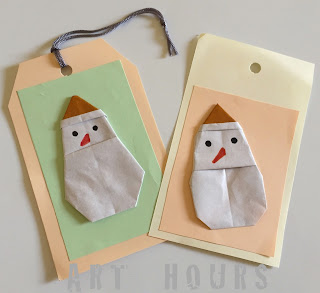 |
| Step 06: Pass the ribbons or strings through the holes made |
Step 07:
Lastly, add messages to your tags. You can either follow a calligraphy style or write messages in your own good handwriting to make it more personal. You can even use stamps or stencils to make it look neat. I leave that option for you to decide.
Lastly, add messages to your tags. You can either follow a calligraphy style or write messages in your own good handwriting to make it more personal. You can even use stamps or stencils to make it look neat. I leave that option for you to decide.
 |
| Step 07: Add personalized messages |
Here's how the Christmas Gift Tags look like after adding the handwritten messages.
You can use these lovely gift tags to tie with your gifts or you can even hang them as decorations on the Christmas tree. If not then you can just gift them to your friends as a small gesture of love and good wishes for the season.
 |
| Christmas Gift Tags with Handwritten Messages |
---
14 Dec 2016
Origami Carnation Flowers Tutorial
Last month, we celebrated the World Origami Day on the 11th of Nov 2016, by conducting an Origami Workshop for the parent and child. You can view the highlights of the workshop here. One of the things the participants enjoyed making was an origami paper basket filled with carnation flowers. It is not an easy model to start with for the beginners, but all the kids with their parents took up the challenge, and each one of them had completed and made a beautiful origami paper basket filled with carnation flowers.
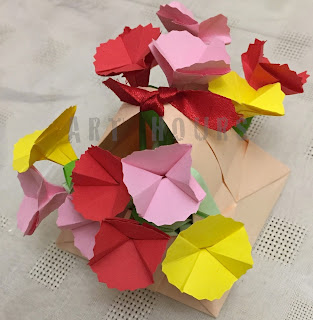 |
| Origami Basket with Carnation Flowers |
Here's a picture that shows the steps for making the Origami flowers using a square sheet of paper. For this tutorial, the size of paper used is 6cmx6cm, but for the workshop, we used origami papers of size 7.5x7.5cm, while for the basket the paper size is 210cm square cut out from an A4 sheet.
Materials required:
- Square paper, again here the size of paper used for the flower is 6cm x 6cm.
- A pair of scissors
- Pencil
 |
| Tutorial for Origami Carnation Flower |
Procedure:
- Step 01: Start by making creases along both the diagonals of the square paper. Note: Here, we have used single colored paper, meaning they are of the same color on both the sides and you don't have to worry which side should be on top.
- Step 02: Turn the paper over and make the creases along the horizontal and verticals of the square as shown in the picture above. You are preparing to make the square base.
- Step 03: Follow the creases and fold to make the square base.
- Step 04: Now, keeping the open side upwards, fold in both the bottom sides as shown in the picture to meet at center.
- Step 05: Turn the paper over and repeat step 04 for this side also.
- Step 06: Now cut the top part using a pair of scissors following an arch shape. You can roughly draw with a pencil for guidelines before making the cuts.
- Step 07: Fold in the bottom tip to touch the top at center, crease well and then fold back.
- Step 08: Now open the flower and flatten from the top following the crease made in last step and the flower is ready.
The origami flower made using the above steps is finally about 3.5cm in diameter. I attached a paper stem with a leaf at the base of every flower.
I shall soon post the tutorial for making the origami basket that we made to hold the flowers. Till then do give this beautiful carnation flowers a try.
Have a good day!
---
1 Dec 2016
Clay Trinkets or Gift Tags using Air Dry Clay
During our clay modeling class, a couple of weeks back, one of my students was working with air dry clay. Usually, we use plasticine clay for our classes, but that week we decided to use some air dry clay. My daughter too wanted to experiment with air dry clay saying that she wanted to make something to gift to her friends. I suggested why not make some Christmas trinkets to gift to your friends since Christmas is just nearby and she could gift them to her friends before the school closes for Christmas break. She dug out some plastic clay molds from her treasure of clay modeling tools and began her play with the clay!
This is how we went about making the clay trinkets...
She used a circular mold to cut out some circles. Thereafter, she used some molds to just press onto the clay surface and created an impression of a flower, a Christmas tree and so on. For adding more details on the outlines made, she used a toothpick. I helped her to make some holes with a toothpick so that we could pass a ribbon or a string through the trinket. I also added some text message using the same toothpick. What started as an experiment actually ended up with some beautiful results. Sometimes, the kids bring out the best in you!
 |
| Air Dry Clay Trinkets left to dry |
Thereafter, we put these clay trinkets to dry for about 48 hours. Later, we applied some acrylic colors to the surface. We were very pleased with the results indeed.
 |
| Air dry clay trinkets painted with Acrylic colors |
Encouraged by the outcome, I made a few more clay trinkets and painted them with acrylic colors. I used some golden strings and some ribbons to pass through these trinkets so that they could either be used as decorations that can be hung on the Christmas tree or use them as gift tags also.
 |
| Air Dry Clay Trinkets |
 |
| Air Dry Clay Trinkets |
All the above clay trinkets are made from air dry clay, which takes around 48 hours to dry further. Also, after applying acrylic paints, I waited for another 24 hours for the paint to dry and then only passed the strings/ribbons.
Each of these clay trinkets measures about 2" or 4cm in diameter. For making the holes while they were wet, I used toothpicks so that I could pass a string through it later. Carving anything on it for the text or even the designs that you see on them with toothpicks requires a lot of patience. Hence, if you wish to try making them keep a lot of time and patience in store with you. You will also need to make the carvings or the designs on it immediately as you cut out the circular shapes since the clay starts drying being exposed to the air. Hence, each piece requires to be completed first before you start rolling out a new one, otherwise adding details to each becomes difficult later.
These clay trinkets can be used as Christmas decorations to hang on the Christmas trees or they can be used as gift tags to be tied with the gifts or you can also use them just to gift it to your friends. After all handmade gifts are loved and appreciated by all, and when they are so beautiful who would not love them!
29 Nov 2016
Watercolor Flowers - Some Basic Techniques
This tutorial highlights the methods of two most commonly used water coloring techniques: wet-on-wet and wet-on-dry. Wet-on-wet means wet paint applied onto the wet paint and wet-on-dry means wet paint applied onto the dry paint. The techniques are not very difficult to master and are fun to try too. Both the techniques produce different effects altogether. The wet-on-wet needs a little experimenting to understand its effects since the colors will spread onto each other and you will need to blend them to get the desired effect, while wet on dry will give sharp edges to the shapes and is comparatively an easier method.
 |
| Water Color Flowers: Basic Techniques |
The following flowers were painted using both the above techniques and you will understand the different results produced once you try them yourself.
Before you start, here are the following materials required:
- A Paper of any size. If you are a beginner, you can use any paper to start with to practice and master the techniques.
- Some Brushes suitable for watercolors
- Water
Flowers painted using Wet-on-dry technique:
For this technique, first you need to apply one layer of painting. Once it dries, you can apply another coat to highlight or add shades or outline the border, as required using the same color or darker shade of the same color or even a different color.
Example 01:
In the painting below, I have first made a flower using a light yellow shade. Then, once the base coat dried, I applied a shade of orange just to highlight the flower's edges and applied some shades to the petals. Thereafter, I applied the black spots at the centre of the flower.
 |
| Example 01: Flower painted using wet-on-dry method |
Here, the rose is also painted using the same technique as above. First I applied a light layer of pink, and once it dried, I applied a layer of yellow.
Example 03:
 |
| Example 02: Flower painted using wet-on-dry method |
Here, I made a base layer of light orange color. Once it dried, I highlighted a few circles with a darker shade of orange. In a similar way, I made the leaves too.
Example 01:
 |
| Example 03: Flower painted using wet-on-dry method |
Flowers painted using Wet-on-wet technique:
For this technique, you need to apply a second layer of painting before the first layer of paint dries and try to blend each layer with the other to get the desired effect.
Here I first applied a layer of dark pink, and before it dried I applied a wash of black paint also onto some petals.
Example 02:
Here, I applied a base color of light orange and while it was still wet, I dipped the same brush in a little black color and applied over a few petals and blended it to get the different shades of the flower petals.
Example 03:
Here, I applied a base coat of one color and while it was still wet, I applied another layer of the same color loading the brush with more color of the same shade and blending it with the existing layer.
 |
| Example 01: Flower painted using wet-on-wet method |
Here, I applied a base color of light orange and while it was still wet, I dipped the same brush in a little black color and applied over a few petals and blended it to get the different shades of the flower petals.
 |
| Example 02: Flower painted using wet-on-wet method |
Here, I applied a base coat of one color and while it was still wet, I applied another layer of the same color loading the brush with more color of the same shade and blending it with the existing layer.
 |
| Example 03: Flower painted using wet-on-wet method |
Try these basic techniques, experiment with different colors and shapes and you will certainly be able to master the basics.
16 Nov 2016
Recycle Magazine Papers to something Useful: Origami Envelope
What would you do with magazine papers or newspapers that would otherwise end up in trash. Try some origami instead. We all know the importance of paper and why there is the need to reuse and recycle them.
You will be surprised to know that despite the digital boom, every household and the corporate world using digital and electronic gadgets, the use of paper however has not reduced. We are using more and more paper every day for different purposes. If we cannot reduce the use of paper, we can play a small role ourselves in recyling them in whatever way we can. A data says that each ton of recyled paper can save 17 trees, 3 cu. yards of landfill space, 4,000 kw of energy and 7,000 gallons of water. This represents around 65% energy savings, around 60% water savings and 60 pounds less of air pollution. Isn't that wonderful!
Recently, I had an Origami Workshop with one of the leading industries in UAE. I was glad that I got this opportunity to show the benefits of practising Origami and the role of Origami in recycling and reusing paper waste. Origami techniques can be used to make a plethora of useful things that would come handy in our day to day lives or can be used in schools and offices too. The options are endless such as: envelopes, bookmarks, pencil toppers, stationery holder, visiting cards cases, wallets, photoframes, coasters, card holders, boxes and containers, and much more...
 |
| Origami - Recycle and Reuse Papers |
Origami - the art of paper folding, doesn't preach you to use colored sheets only. Infact, Origami is a great way to recycle paper. Instead of using expensive colored sheets to practice origami, it is better if you use newspapers or magazine papers to fold the complex models before you get the steps right. Not only will it give an idea of how your final model will look, but will also tell you about the right size and type of paper to be used. For example, an origami model that requires several folds, would work best using a thin quality of paper. Similarly, if you need to make several folds, it will be a difficult exercise if you use a small sized paper. So, its better you try folding them several times using newspaper or magazine papers, before you make the final origami project.
Here's a brief tutorial that shows how you can make an envelope from a magazine paper.
The design and pattern on the magazine page will affect the final outcome of your origami project. Hence choose your paper accordingly.
The papers used in the tutorial below are around 8"x12" rectangles cut out from an old magazine. We need to cut them into squares. So here's how we cut them into squares without using any tools or measurements.
 |
| Magazine papers for Origami |
Hold the top left corner and fold it to touch the bottom edge as shown in the picture below. You will get a triangular shape, but make sure that the bottom edges are aligned perfectly. Cut off the remaining rectangular part to get a square paper.
 |
| Cutting a rectangular paper into a square |
You will get squares of around 8"x8", depending on the size of the magazine paper.
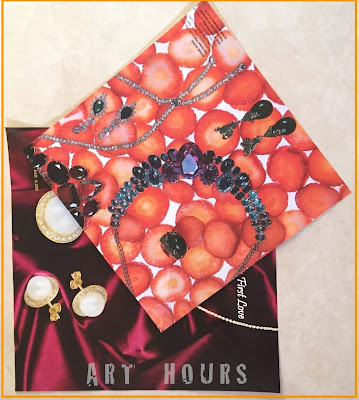 |
| Square papers from rectangular sheet |
Tutorial for folding an Origami Envelope using a Magazine paper
Step 01:
Start with a square sheet of paper, keeping the side you want to be used on the top as shown. Here the size is 7.5"x7.5" square paper.
 |
| Step 01: Start with a square paper keeping the colored side on top |
Fold it into half along the diagonal. Keep the coloured side or the side you want to be seen on the top.
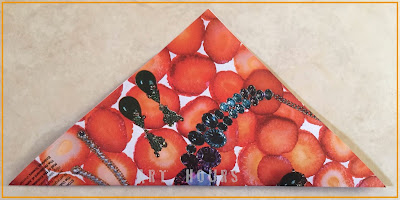 |
| Step 02: Fold into half diagonally |
Now, take the top flap and fold it down to touch the bottom edge at centre. At this step you can glue the flap to the bottom or leave it as it is.
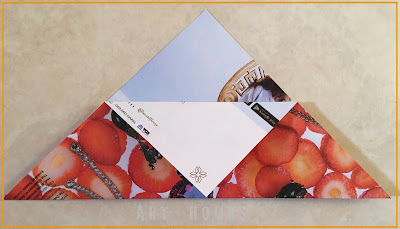 |
| Step 03: Fold in the top flap to touch the bottom edge at centre |
Step 04:
Now, take the left corner and fold it in as shown. Actually the bottom edge can be divided into 3 equal parts aproximately. You can use a scale to measure and mark the edge using a pencil into three equal parts if required. Then it makes it easier to fold the left corner to about one third part over to the right side. Glue the flap if needed at this stage.
 |
| Step 04: Fold in the left corner to about 1/3rd part over to the right |
Step 05:
Similarly, take the right corner and fold it to about one third part over to the left side. Don't apply glue at this stage.
 |
| Step 05: Fold in the right corner to 1/3rd part to the left side |
Fold the flap back touching the right end as shown.
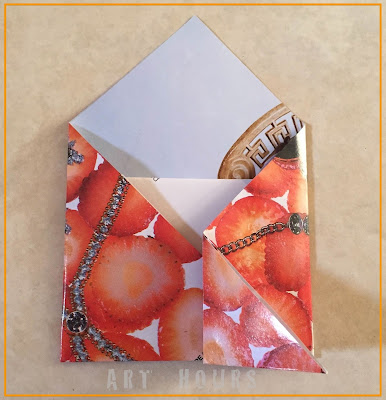 |
| Step 06: Fold the flap back touching the right end |
Open the small flap as shown.
 |
| Step 07: Open the flap |
After opening the flap, flatten it well to get a square shape as shown. This will help to seal and secure the envelope without the use of any glue.
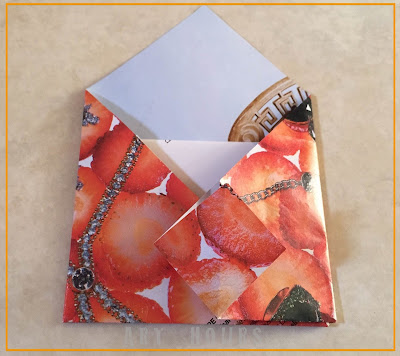 |
| Step 07 (contd.): Squash or flatten the flap to get a square shape |
Fold the top corner of the envelope down and crease well.
 |
| Step 08: Fold the top corner down |
Tuck the top flap of the envelope into the bottom square pocket you formed in step 07.
 |
| Done: Tuck in the top flap into the square pocket as shown |
The envelope is ready. The top flap is secured into the bottom square. You don't need any glue to secure it further and a beautiful envelope is ready to use.
 |
| Origami Envelope from recycled magazine paper |
The final size of the envelope is around 3.5"x 2.75". You can use a bigger sized sheet to get a larger sized envelope.
Make some envelopes with the magazine papers or fold them into interesting origami creatures. Its your choice if you want to recycle and reuse the paper to make something useful or make something for fun. Rest for sure, both are better options than to just throw these beautiful, glossy and colorful sheets into the trash bin.
Make some envelopes with the magazine papers or fold them into interesting origami creatures. Its your choice if you want to recycle and reuse the paper to make something useful or make something for fun. Rest for sure, both are better options than to just throw these beautiful, glossy and colorful sheets into the trash bin.
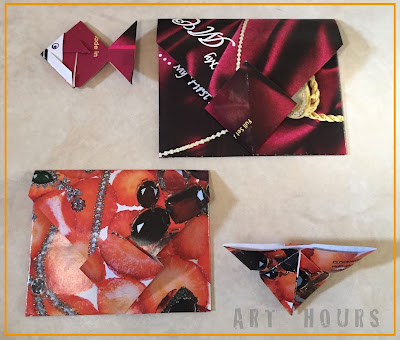 |
| Origami using Magazine papers |
---
Labels:
easy DIY,
envelope,
go green origami,
magazine paper,
magazine paper crafts,
origami envelope,
recycle,
recycle magazine papers,
reduce,
reuse,
useful origami,
waste to best
Location:
Dubai - United Arab Emirates
Subscribe to:
Posts (Atom)


